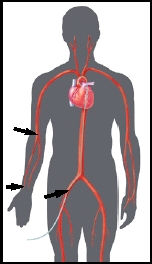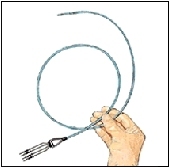Welcome to the medical library of Hartford Cardiology Group. The information shared below is provided to you as an educational and informational source only and is not intended to replace a medical examination or consultation, or medical advice given to you by a physician or medical professional.
If you have any questions or concerns regarding any condition or treatment, please contact Hartford Cardiology Group. To schedule an appointment please call (860-547-1489) or [email protected].
Electrophysiology Study (EPS)
An EPS closely monitors your heart rhythm. EPS can help determine exactly what your rhythm problem is and what can be done to control it. A specially trained doctor (electrophysiologist) performs the procedure in an EPS lab.

Insertion sites may be in the groin or the arm.

The electrode catheter is a thin, flexible, coated wire
Before the Procedure
- Tell your doctor which medications you take. Ask if you should stop taking them before the procedure.
- Have any routine tests that your doctor recommends.
- Don’t eat or drink anything after midnight, the night before the procedure.
During the Procedure
- The study takes about 1-4 hours.
- After the skin is numbed with a local anesthetic, an incision is made where the catheter will be inserted.
- One or more catheters are passed through the veins and positioned in the heart.
- The catheters record electrical activity of the heart. They find where and when signals begin and how often they are sent.
- Other procedures that may be done during the study include defibrillation (electric shock to the heart to help adjust the heart rhythm) and catheter ablation (destruction of an abnormal electrical pathway or cells in the heart).
Call Your Doctor If:
- The insertion site has pain, increased swelling, redness, bleeding, or drainage.
- You have shortness of breath or angina (chest pain).
- You have severe pain, coldness, numbness, or a bluish color in the leg or arm that held the catheter.
- You have a fever over 100.0°F.
After the Procedure
- You’ll need to remain lying down for 6-12 hours.
- If the insertion site was in your groin, you may be asked not to move your leg for several hours.
- A nurse will check the insertion site and your blood pressure.
- After the study, you usually remain in the hospital for several hours or overnight.
